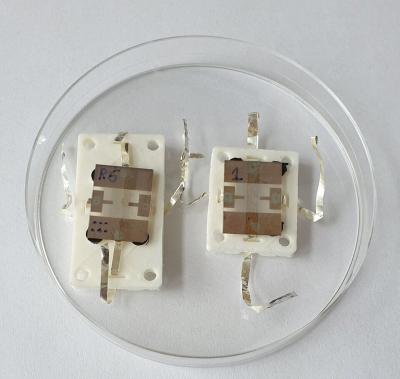The European Space Agency (ESA) has announced that a project it has backed has yielded a combined temperature and magnetism sensor. Any time we can do more with less is a good result for the space sector, notes ESA materials specialist Ugo Lafont. Thanks to the unique properties of graphene, our prototype bi-functional sensor can measure magnetic field strength at the same time as taking temperature readings.
 Prototypes of bi-functional sensor by ESA and AGP image
Prototypes of bi-functional sensor by ESA and AGP image
And our tests show the sensor operates reliably from room temperature down to 12 degrees Kelvin. Normally separate temperature sensors are required to accurately measure such wide temperature ranges, right down to cryogenic levels.
The intrinsic electrical resistance of graphene changes as a function of temperature, and this allows the sensor to make very precise measurements across the temperature scale, adds Ugo. In addition the sensor employs a phenomenon called the Hall Effect, where a voltage difference is produced across an electrical conductor by the presence of a magnetic field".
That might sound straightforward enough but to make the design work in practical terms we needed an extremely high quality, large-scale sheet of graphene, nearing a square centimeter in scale. This is where our partner came in, Advanced Graphene Products in Poland.
Advanced Graphene Products (AGP) employs a deposition method for the production of graphene, where a graphene layer is built up on a surface, first developed at Poland’s Lodz University of Technology.
Our High Strength Metallurgical Graphene involves forming graphene flakes on the surface of liquid copper, precipitated from a copper-carbon solution, explains Dominika Kuten. This differs from the solid surfaces our competitors employ for standard chemical vapor deposition.
This liquid surface is so smooth by comparison to its solid equivalent that the graphene flakes match up to each other, minimizing overlapping and mismatches. We have implemented our technology for mass production, and can produce graphene sheets of up to 1 m in length.
The next step was to align AGP’s graphene sheet to the sensor’s electrical connectors with molecule-scale precision, then safely encapsulate it, a task performed by the PORT Polish Center for Technology Development.
Testing of the prototype sensor took place at AGP as well as Lodz University of Technology, demonstrating precision down to a hundredth of a degree.
As well for space, the potential is there for use in a lot of other markets, including for cryogenic equipment, in energy and power markets, even for food and beverage production, adds Ugo.
The scientists said that the next step will be to make the design even smaller and more user friendly, while also working on other graphene-based sensor concepts, such as detecting trace levels of contaminants, or even microbes, below the detection threshold of traditional sensors.
More broadly we’ve been looking into adding graphene for better batteries and other energy storage methods, as well as an added ingredient of various materials, to augment their strength and electrical properties.